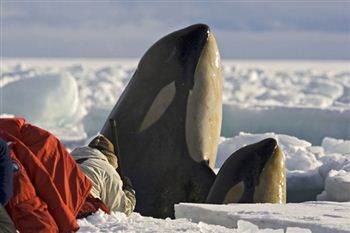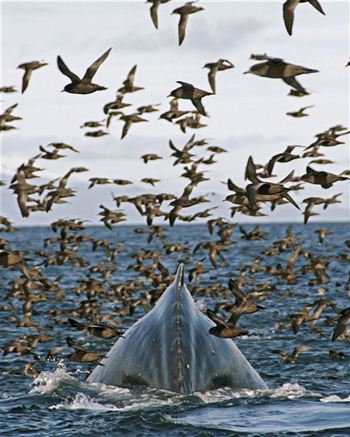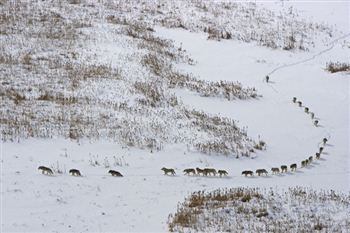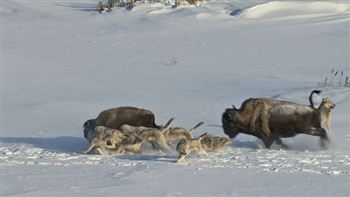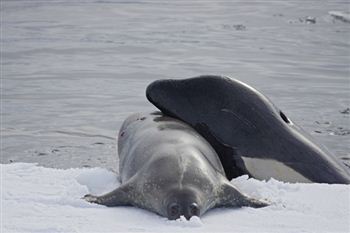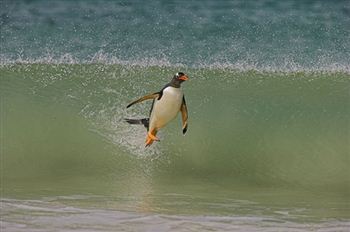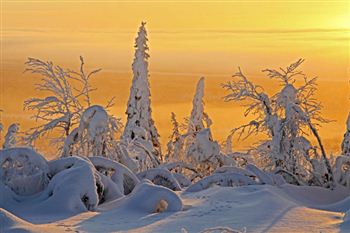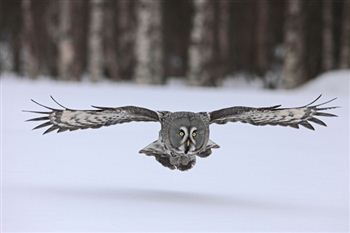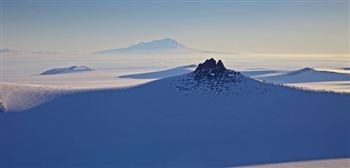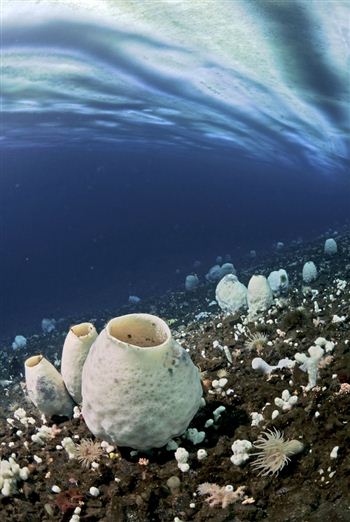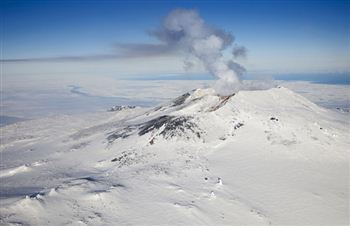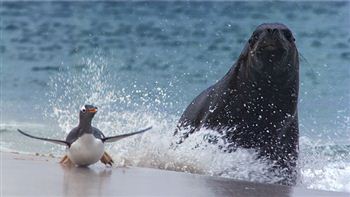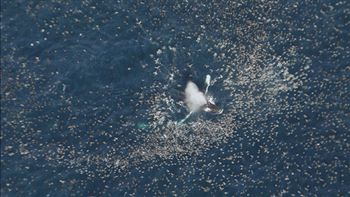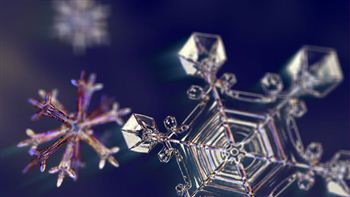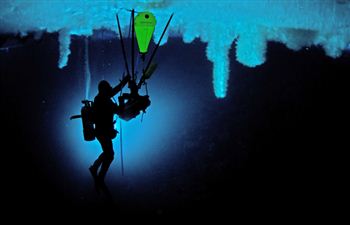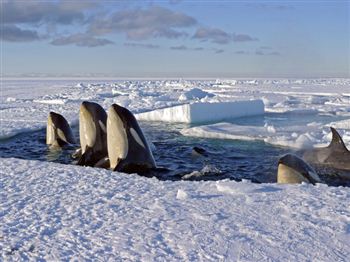Stunning images of barren polar landscapes and the animals which inhabit them have been released to celebrate a new documentary.
Frozen Planet features footage of timberwolves hunting bison in Northern Canada, a great grey owl in the Arctic and shearwaters swarming round a whale off Alaska.
The programme starts on BBC1 at 9pm on October 26.
Male polar bear follows female, showing battle scars. The size difference is clearly illustrated – the male weighs twice as much as she does. The Frozen Planet crew filmed the entire courtship sequence over a fortnight, capturing extraordinary intimate and tender moments.
The male had to defend his interests in the female by fighting off at least ten rival males. By the end of the period, he was covered in blood and limped away into the sunset. But at least he had ensured that his female hadn’t mated with any other males.
This would guarantee that the cubs that she would give birth to in nine months time would be his. He returns to his solitary ways out on the sea ice and will never see his mate again. (Picture by Jason Roberts)
Lying belly-down on Antarctic sea-ice at the edge of a small hole, a cameraman gets a shock when a killer whale mother and calf explode out of the water in front of his face.
The only way to get underwater images was to hand-hold a camera on a pole in the icy water, wait and hope. As the orcas came up to breathe they wouldeye-ball us with curiosity and spray oily breath all over our faces.
To be on your stomach precariously perched on the edge of the ice with a killer whale staring down at you was simultaneously terrifying and awe-inspiring. (Picture by Chadden Hunter)
A humpback whale dives for krill amidst thousands of short-tailed shearwaters. It’s mid-summer in the Bering Sea, off Alaska’s Aleutian Islands. Cold water and long sunny days leads to some of the richest seas in the world.
Humpbacks have travelled for months from Hawaii and shearwaters the length of the planetfrom Australia. So busy gorging on the summer bonanza, they barely get out of each other’s way.
Filming from the boat, we watched shearwaters accidentally fly straight into the side of breaching whales, and humpbacks accidentally swallow and spitout shearwaters. This is the largest gathering of seabirds on the planet – 18 million. (Picture by Chadden Hunter)
A massive pack of 25 timberwolves hunting bison on the Arctic circle in northern Canada. In mid-winter in Wood Buffalo National Park temperatures hover around -40C degrees.
The wolf pack, led by the alpha female, travel single-file through the deep snow to save energy. The size of the pack is a sign of how rich their prey base is during winter when the bison are more restricted by poorfeeding and deep snow.
The wolf packs in this National Park are the only wolves in the world that specialise in hunting bison ten times their size. They have grown to be the largest and most powerful wolves on earth. (Picture by Chadden Hunter)
The pack force the herd to stampede after hours of harrying them.
Their hope is that a yearling will fall behind. This yearling’s fate was actually sealed by another member of the herd which ran headlong into it! (Picture by BBC)
An orca takes a seal and drags it into the water to drown it. This was after a three hour team hunt in which the entire pod co-operated in order to make giant waves that washed the seal from its initial ice floe, and then did side swipes with their tail, blew bubbles, rolled the ice floe and then eventually dragged the seal to its death.
It is partly done as a training exercise for the younger members of the pod but is also to ensure that the seal is exhausted and won’t turn round and attack.
Captain Scott witnessed these hunts over 100 years ago and scientists today think that they may be the most complex team hunts in the natural world. (Picture by Robert Pitman)
Gentoo penguin (Pygoscelis papua papua) surfing on wave.
These penguins are masterful surfers. We filmed them in high speed as they came ashore to feed their young – Picture by Andy Rouse / naturepl.com)
Frozen taiga forest in magical light, Finland. The Taiga is the greatest forest on Earth, containing at least a third of all the world’s trees.
The vast stretches of forest are restricted to one or two species of tree, usually conifer. Life is scarce in these forests as conifer needles are hard to digest.
Some of the trees can be loadedwith as much as three tonnes of snow. This is why conifers tend to be cone shaped with sloping sides to encourage the snow to slide off. (Picture by Fredi Devas)
Great grey owl in flight. One of the largest owls in the world with a wingspan of between four to five feet; it is often referred to as the Great Grey Ghost or Phantom of the North as it is so reclusive.
Unlike dark-eyed nocturnal owls, it has distinctive piercing eyes, which may be an adaptation to hunting by day. (Picture by Fredi Devas)
A nunatak pokes through the ice sheet in Antarctica. 90% of the world’s ice is found here in Antarctica where the ice is nearly three miles thick in places and the ice cap drowns entire mountain ranges. This shot was taken as we were beginning to fly the route that Scott and his men took nearly 100 years previously. (Picture by Vanessa Berlowitz)
Underwater life under Antarctic ice, McMurdo Sound. Below 30 metres the seabed is safe from the scouring action of “anchor ice” and is covered with giant sponges that can be up to 2 metres high and as much as a thousand years old. (Picture by Hugh Miller)
An early-morning view of Mt Erebus, Antarctica’s only continuously active volcano and the most southerly active volcano on the planet.
On still days the gas plume is hardly visible. The aerial crew waited eight weeks in order to get this clear view of the top of the volcano which was often shrouded in cloud and extremely treacherous to fly around. (Picture by Vanessa Berlowitz)
A sea lion chases a gentoo penguin onto land – both are like fish out of water and the sea lion struggles to make a kill. (Picture by BBC)
Aerial shot of a humpback whale amongst shearwaters (Picture by BBC)
Snowflake close up detail – this is filmed with unique macro technology developed especially for the shot. (Picture by BBC)
Giant iceberg hundreds of metres across. This single piece of ice would dwarf most of mankind’s buildings. It collapsed from Store Glacier on the west coast of Greenland in July 2010. (Picture by BBC)
Aerial shot of sapphire blue meltwater lake on Greenland ice sheet. It formed in a matter of days, was several miles wide and carved a meltwater channel through the ice eventually plunging a vertical mile into the heart of the ice sheet.
Although tempting to go for a dip in the middle of the day, it was sobering to think that you could get sucked out and swept down the moulin. Several weeks later a crack appeared on the lake bed and the entire lake drained into the ice sheet in a matter of hours. (Picture by Vanessa Berlowitz)
Cameramen Dough Anderson and Hugh Miller created a bespoke underwater tripod which they bolted to the ice ceiling.
They were able to get extraordinarily stable, macro shots of theses amazing ice formations or “ice chandeliers”, which were inhabited by millions of tiny ice fish whose bodies were full of anti-freeze.
Under icediving is not for the faint-hearted – it is the most high risk diving in the world. Our crew dived a record 110 times in one Antarctic season and spent hours under the ice capturing this magical world. (Picture by Hugh Miller)
Pod of orcas spyhopping amongst the breaking sea ice, Ross Sea, Antarctica 2009. The Orca’s spyhop through gaps in the ice to determine how they can reach new fishing grounds. They have extremely poor sight.
Our team filmed them simultaneously from the air, ice, and from underwater with a camera attached to a polecam. This fish-eating orca is distinctly different from the one that hunts seals.
It is now even thought to be a different species. Their bellies are characteristically stained yellow from feeding on diatoms in the rich Antarctic waters.
The crew were dropped into position by helicopter in order to film these unique shots. They were standing on no more than a metre or two of sea ice at the time. (Picture by BBC/Chadden Hunter)


